#neptune resigning to Britannia the empire of the sea
Text
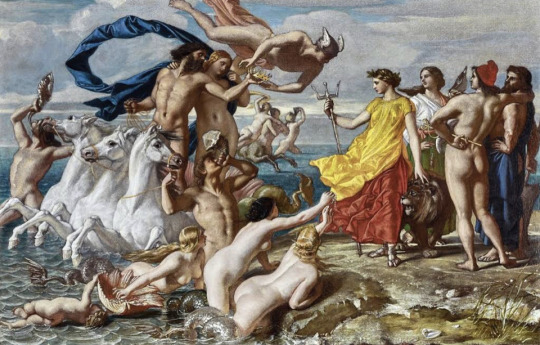
My new favourite painting.
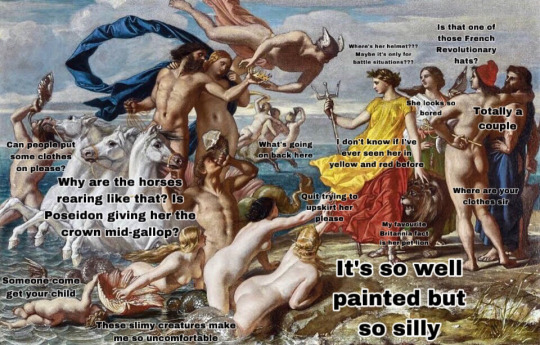
#neptune resigning to Britannia the empire of the sea#by William Dyce#not to mention the chap swooping in at the top#even Britannia is there like ‘‘What on earth is going on?’’
2 notes
·
View notes
Text

'Neptune Resigning To Britannia The Empire Of The Sea'. William Dyce. 1847.
82 notes
·
View notes
Text
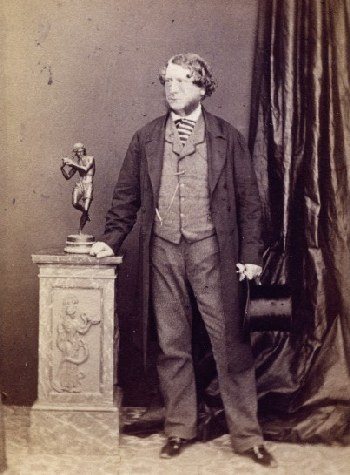






19th September 1806 saw the birth of William Dyce, the painter and educator.
Born at 48 Marischal Street in Aberdeen to a well off family William was educated at the Royal Academy schools, and then travelled to Rome for the first time in 1825. While he was there, he studied the works of Titian and Poussin.
Dyce was highly cultured and widely talented (he was an accomplished musician and wrote learned essays on antiquities and a prize-winning paper on electromagnetism), but initially he was successful mainly as a rather conventional portraitist in Edinburgh.
In 1837 he moved to London to work for the newly founded Government School of Design (which developed into the Royal College of Art) and he made a tour of state art schools in France and Germany to study their methods. His report on his findings led to his appointment as superintendent (director) of the School in 1840. He resigned in 1843, but he remained a central figure in the art world—indeed ‘there was no major [artistic] undertaking in mid nineteenth-century Britain in which he did not play either an executive or advisory role’.
In particular he was a key figure in the revival of fresco painting, which was stimulated mainly by the mural decoration (begun 1843) of the new Houses of Parliament. Dyce's own work there has deteriorated badly, but his Neptune Resigning to Britannia the Empire of the Sea is one of the best preserved of all Victorian frescos. This was one of several royal commissions for Dyce, who was a favourite of Prince Albert. In addition to murals, he produced a varied range of easel paintings, from high-minded religious scenes (he was a devout Christian) to the delightfully sentimental Titian's First Essay in Colour his Pegwell Bay, Kent is considered one of the most remarkable of all Victorian landscapes.
Dyce's strong colours, firm outlines, naturalistic detail, and thoughtful sincerity of approach formed a bridge between the Nazarenes and the Pre-Raphaelites, and Ruskin said that it was Dyce who gave him his ‘real introduction’ to the Pre-Raphaelites when, at the 1850 Royal Academy exhibition, he ‘dragged me literally up to the Millais picture of the Carpenter's Shop, which I had passed disdainfully, and forced me to look for its merits’.
He was working on the frescoes in Westminster when he collapsed, and later died at his home in Streatham on 14 February 1864. He was buried at St Leonard's Church, Streatham. A nearby drinking fountain, designed in the neo-Gothic style by Dyce, was subsequently dedicated to him by the parishioners.
My favourite painting of his that I have seenis the one of the inside of Rosslyn Chapel.
6 notes
·
View notes
Text
Südengland 2023 - Tag 21
Ladies and Gentlemen!
Der heutige Tag widmet sich einer geschichtsträchtigen Epoche: Kein Landsitz wurde von Königin Viktoria so sehr geliebt wie das Osborne House auf der Isle of Wight.
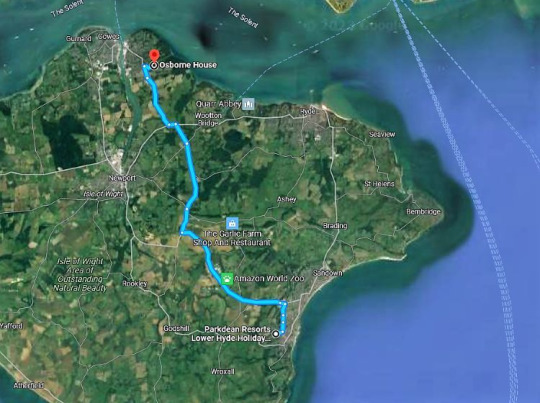
Die als “Großmutter Europas” bekannt gewordene Monarchin war von 1837 bis 1901 die Königin des Vereinigten Königreichs Großbritannien und Irland.

Sie bewies schon damals eindrucksvoll, dass grundsätzlich alle Queens, anstrengender Regierungsgeschäfte zum Trotz, eine recht hohe Lebenserwartung haben.

Da man auch im 19. Jahrhundert schon manches Mal dem Stress entfliehen musste, kaufte sie zusammen mit ihrem Mann Prinz Albert im Jahr 1845 ein Grundstück auf der Insel. Natürlich mit Blick auf den Solent.
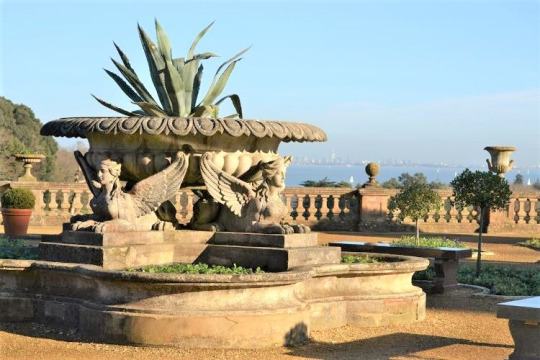
Den Stress als Monarchin während des nach ihr benannten Viktorianischen Zeitalters darf man sich übrigens etwas größer vorstellen als heute.

Während Queen Elisabeth II. als repräsentatives und farbenfrohes Schmuckstück bei Paraden her halten durfte, war Viktoria zu ihrer Zeit immerhin Herrscherin eines Fünftel der Landmasse der Erdoberfläche sowie eines Drittels der Weltbevölkerung.

Unvorstellbar, dass man sich mit dieser Bürde überhaupt ein Zurückziehen in eine Sommerresidenz leisten konnte. Tatsächlich aber verbrachte Viktoria viel Zeit im Osborne House. Sogar für ihren sich abzeichnenden Tod im Alter von 81 Jahren wählte sie dieses Haus aus.
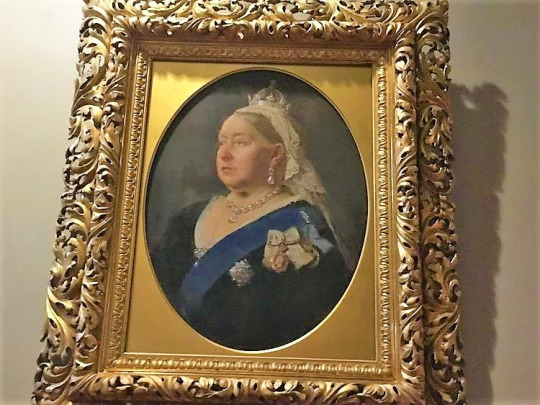
Als Königin Victoria und ihr Ehemann, Prinz Albert, nach einem privaten Landhaus für ihre wachsende Familie suchten, fanden sie das Osborne House auf der Isle of Wight.

Die Wahl fiel nicht ganz zufällig auf die Isle of Wight. In früher Kindheit hatte Viktoria bereits zweimal ihren Urlaub auf der südenglischen Insel verbracht.

Osborne liegt nahe der Nordostküste der Insel zwischen Cowes und Ryde. Es war damals ein dreistöckiges Backstein- und Steinhaus, das Ende des 18. Jahrhunderts erbaut wurde.
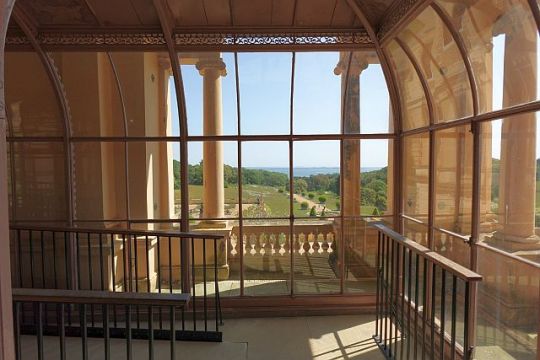
Victoria und Albert besuchten das Haus 1844 und waren von seiner Lage begeistert. Victoria kaufte das Anwesen für 28.000 Pfund aus ihrer Privy Purse (Privatschatulle).

Das ursprüngliche Haus auf dem gekauften Grundstück wurde kurzerhand abgerissen und ein neuer Palast mit Blick auf das Meer gebaut.

Albert stürzte sich in den Wiederaufbau des Hauses im italienischen Stil und erweiterte das Anwesen, indem er benachbarte Farmen aufkaufte.
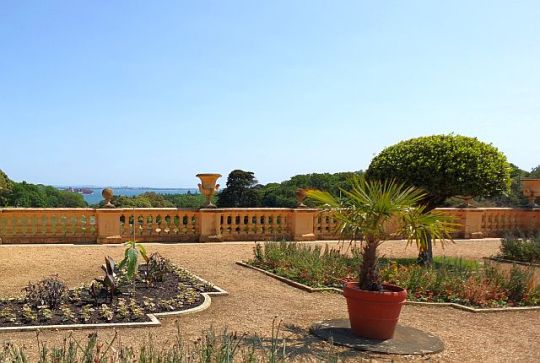
Es blickt nach Nordosten, einen breiten Weg hinunter zum Meer, mit Portsmouth auf der anderen Seite des Solent. Jedes Jahr verbrachte die Familie hier so viel Zeit wie möglich.

Auch das Innere des Osborne House kann sich sehen lassen. Bei der Inneneinrichtung wurde (meiner bescheidenen Meinung nach) weniger auf dem Geschmack geachtet, sondern in royaler Absicht so richtig Vollgas gegeben.

Bei unserem Rundgang durch das Haus hat es uns, beim Anblick dieser Geschmacklosigkeiten, nicht nur einmal geschüttelt. Selbst das Heritage Personal gab gelegentlich ein “It´s awful” oder “It´s over the top” von sich.
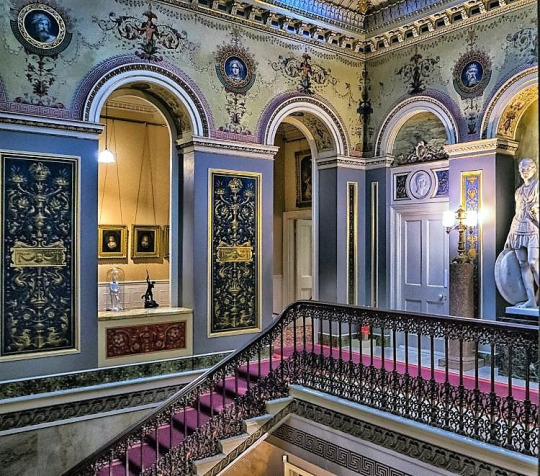
Natürlich lässt sich über den Geschmack und Stil der damaligen Zeit vortrefflich streiten. Allerdings darf man auch nicht vergessen, dass man mit der schieren Masse an kunstvollen Einrichtungsgegenständen und Wandverkleidungen potentielle Besucher anderer Länder nur vom eigenen Reichtum überzeugen und beeindrucken wollte.

Was dabei heraus kommt, wenn man nahezu unbegrenzte finanzielle Mittel zur Verfügung hat, kann man hier vortrefflich sehen.
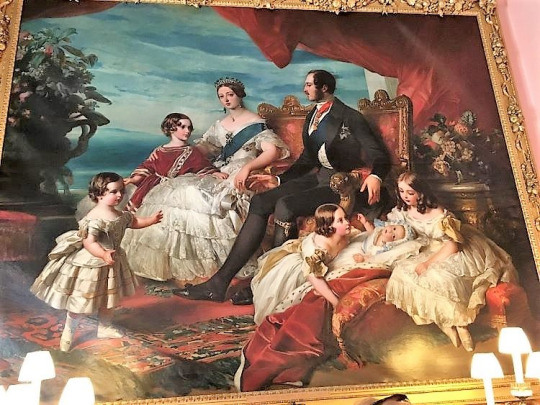
Nach Alberts frühem Tod, im Jahr 1861, verbrachten Victoria und ihre Kinder weiterhin einen Großteil ihrer Zeit in Osborne.
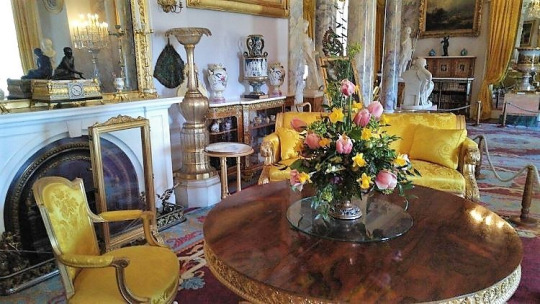
Die verwitwete Königin beließ Alberts Ankleide- und Schreibzimmer absolut unverändert. Sie ging sogar so weit, dass jeden Morgen heißes Wasser dorthin gebracht wurde.

Allerdings befindet sich Alberts Sammlung italienischer Renaissance-Kunst heute in der Nationalgalerie und anderen Museen, und die meisten der ausgestellten Gemälde stammen aus dem 19. Jahrhundert.

Besonders amüsiert hat uns dieses gewaltige allegorische Fresko auf der Haupttreppe: „Neptune Resigning the Empire of the Seas to Britannia“.

Ihm gegenüber steht eine fast lebensgroße Statue von Albert als klassischer Krieger: ein Geburtstagsgeschenk der Königin. Naja ... über Geschmack lässt sich eben nicht streiten.

Gegen Ende ihres Lebens war Victoria von allem indischen fasziniert: Sie beschäftigte zwei indische persönliche Bedienstete, und der Durbar-Flügel wurde in den 1890er Jahren gebaut.

Das Besondere an diesem Raum ist seine originalgetreue Inszenierung.

Dieser Saal für Bankette wurde komplett nach indischem Vorbild mit originalen Elementen gebaut. Selbst der Teppich kommt aus Agra, der Stadt des Taj Mahals.

Allerdings ist der vermeintliche prachtvolle Stuck gar kein Stuck, sondern nur Pappmaché. Das verriet uns eine der Damen des English Heritage, die im selbigen Raum ihren Wachdienst ausübte.
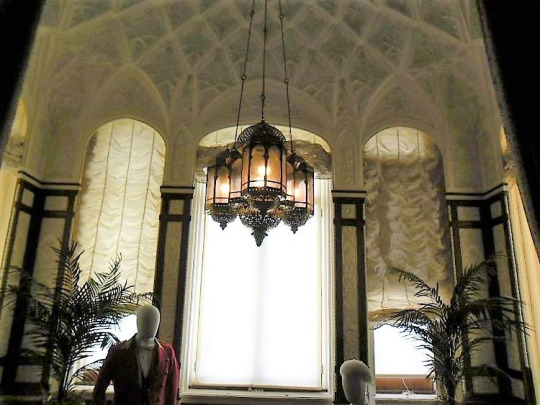
Der Durbar-Raum hat eine, die von einem indischen Handwerker, Bhai Ram Singh, unter der Leitung von Lockwood Kipling, dem Vater von Rudyard (das Dschungelbuch), hergestellt wurde. Ram Singh entwarf auch die Türklinken und die Stühle.

Der Korridor zum Durbar Room zeigt Porträts indischer Prinzen und Damen in voller Montur. Zur Anfertigung dieser Bilder wurde eigens ein Künstler nach Indien geschickt.

Als man in Archiven Fotos von einem Bankett im Durbar Room entdeckte, entschied man sich die Tafel, gemäß alter Fotografien, nachzubauen.

So unterscheidet sich der Raum heute auch dadurch von anderen Zimmern, da er nicht blind mit unzähligen Antiquitäten voll gerümpelt wurde, sondern einen Eindruck vom tatsächlichen Füllungsgrad eines Raums auf Osborne gibt.
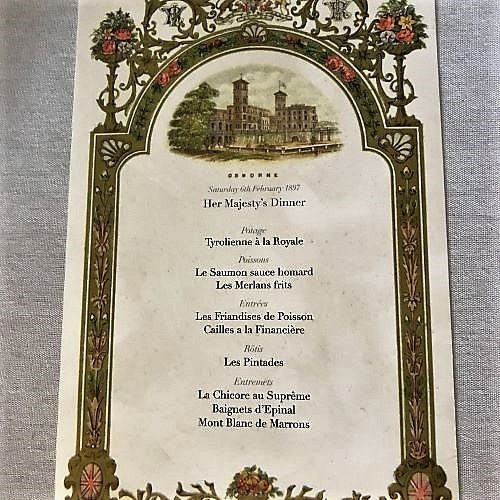
Der zweite Stock des Gebäudes gibt dem Besucher einen Eindruck in die damalige Kindererziehung. Zur Zeit von Viktoria war es üblich, seinen Nachwuchs in einen anderen Teil des Gebäudes zu stecken. Das Zusammenleben als Familie war damals kein erklärtes Ziel.

Da die Königin sich in diesem Teil des Palastes eher selten blicken ließ, sind die Zimmer dort auch schmuckloser ausgestattet.
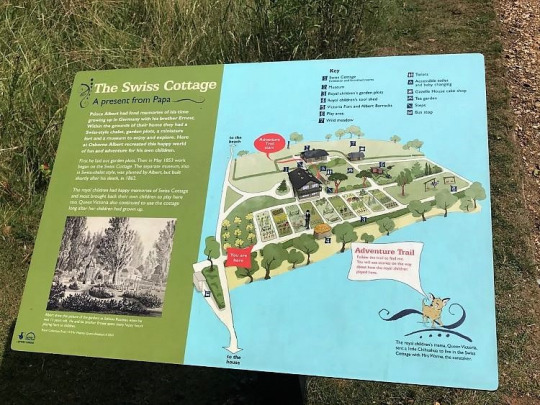
Apropos Kindererziehung: Prinz Albert, dessen deutsche Wurzeln im Vereinigten Königreich zuerst gar nicht gut ankamen, ließ sich ein Holzhaus aus der Schweiz liefern.
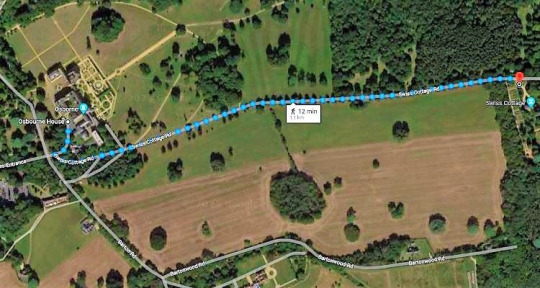
In einiger Entfernung (etwa 1 km) auf dem Gelände befindet sich dieses Swiss Cottage, das Albert 1854 für die königlichen Kinder erbaute.

An diesem Platz übernahm er persönlich einen Teil der Erziehung seiner Kinder.

Hier erhielten sie Gartenparzellen, auf denen sie mit ihren eigenen Händen Blumen, Obst und Gemüse anbauen konnten.
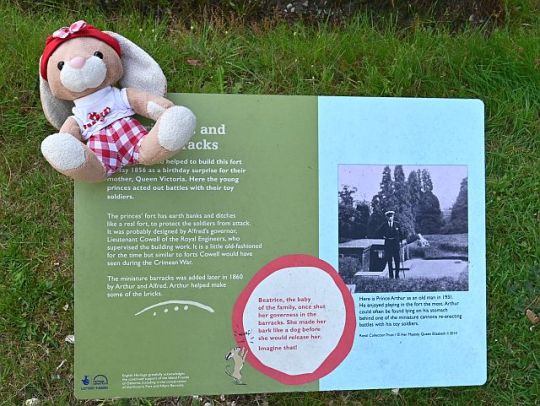
Es gibt auch Miniaturbefestigungen (Victoria Fort and Albert Barracks), in denen Bertie (der zukünftige König Edward VII.) Soldat spielen konnte.
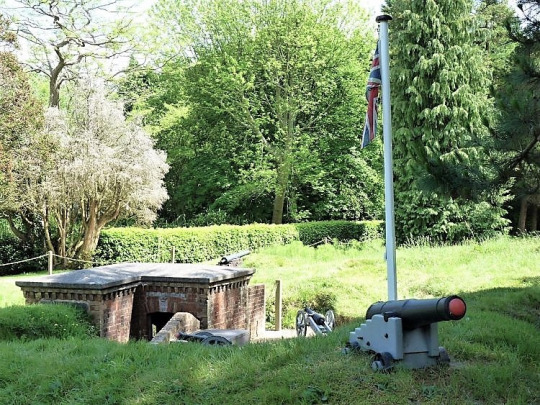
Zwischen dem Swiss Cottage und den Victoria Fort and Albert Barracks liegt heute der Tea Room unter schattigen Bäumen.

Selbstverständlich wäre ein Landhaus am Meer nur halb so erholsam, wenn nicht auch ein Strand dazu gehören würde.
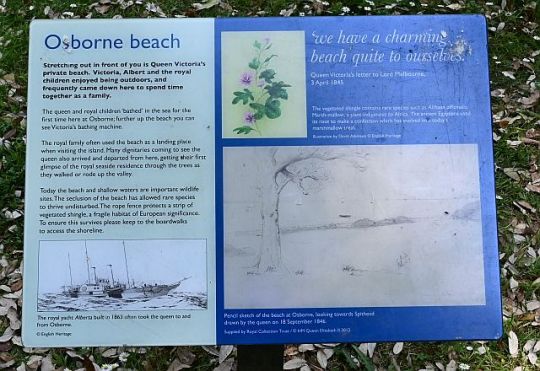
Genau deswegen verfügte das Osborne House über einen Privatstrand an der nördlichen Küste der Isle of Wight, welchen wir uns am Ende des Rundgangs natürlich auch unbedingt ansehen wollten.

Da das Baden als Frau - und insbesondere als Königin - damals so eine ganz diffizile Sache war, griff man auf rollbare Badekabinen zurück.
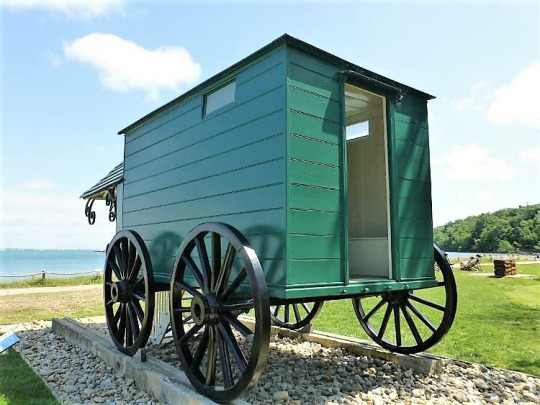
Die kutschenähnlichen Gefährte wurden an einem Seil ins Wasser gelassen, so dass man sie bequem als Badeplattform nutzen konnte.

Ein geschütztes Umziehen war so jederzeit im Inneren der wasserdichten Kabine möglich.
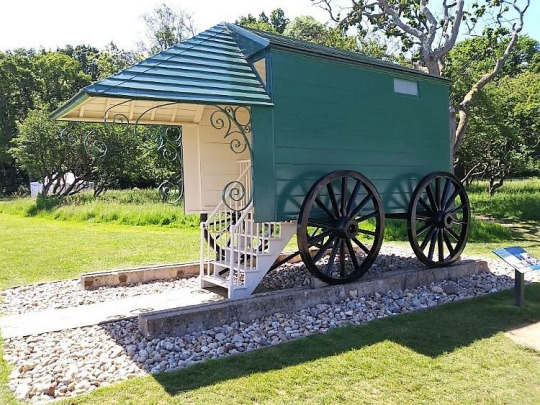
An dieser Stelle muss man natürlich erwähnen, dass züchtige Badebekleidung zur damaligen Zeit keinen Zentimeter blanker Haut freigeben durfte.

Hier unten gibt es heutzutage ein sehr beliebtes Eiscafé, dass die Inseleigene Gourmet-Eiscreme “Minghella” im Angebot hat.

Das Eis der Firma Minghella wurde schon mehrfach mit den Great Taste Awards ausgezeichnet, die so etwas wie die Oscar’s in der britischen Welt der Nahrung und Genüsse darstellen.
Inzwischen gibt es sogar eine “Dog Icecream” mit so interessanten Geschmackrichtungen, wie: “Chicken Livers”, “Fillet Steak” oder “Roast Pork”. Ein Verkaufsschlager!

Bei dem strahlenden Wetter war es schwierig hier unten noch einen Sitzplatz zu ergattern. Kaum wurde etwas frei, schon kam jemand zielstrebig darauf zu.

Königin Victoria starb im Januar 1901 in Osborne. In Erwartung ihres nahen Todes hatten sich viele ihrer Familienmitglieder dort versammelt, darunter auch ihr Enkel, Kaiser Wilhelm II. von Deutschland.
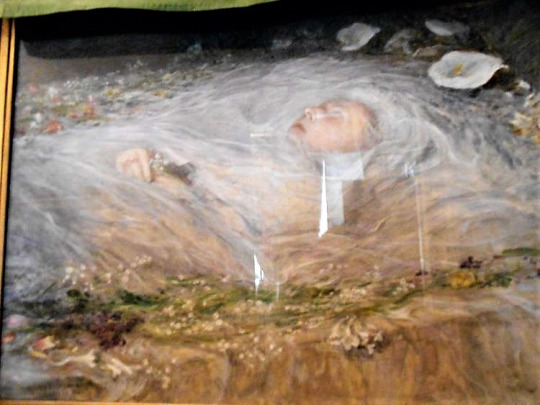
Der neue König, Edward VII., hatte keine Verwendung für das Haus, und es wurde als Genesungsheim für Armeeoffiziere genutzt.
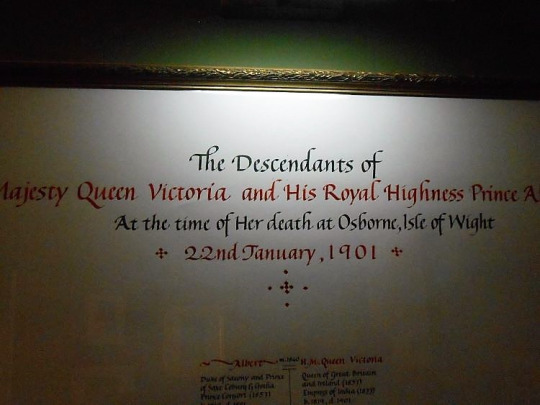
Nachdem das Osborne House im Jahr 1903 dem britischen Volk geschenkt wurde, konvertierte man die Räume nach und nach zu musealen Ausstellungsräumen.
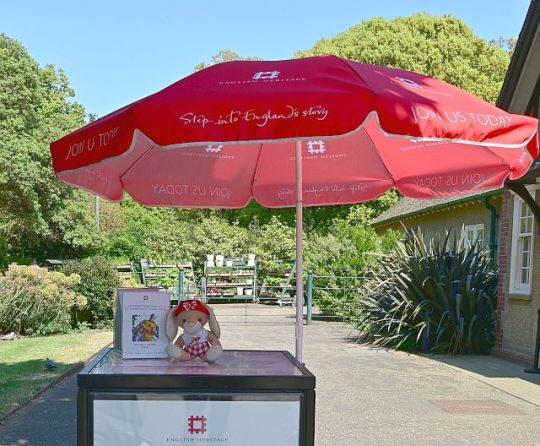
1954 wurde es der Öffentlichkeit zugänglich gemacht und 1986 von English Heritage übernommen und betrieben.

Die Eintrittspreise stehen denen von Stonehenge in nichts nach: 26 £ sind kein Schnäppchen. Zum Glück können wir hier noch einmal unseren Heritage Pass einsetzen.

Inklusive ist darin allerdings auch ein Shuttleservice, der Fußkranke (und alle die sich dafür halten) mit kleinen Elektrobussen auf dem Gelände hin und her fährt.

Auf dem Rückweg zu unserer Unterkunft kommen wir an dem Gelände vorbei, auf dem das legendäre Isle of Wight Festival stattfinden wird.
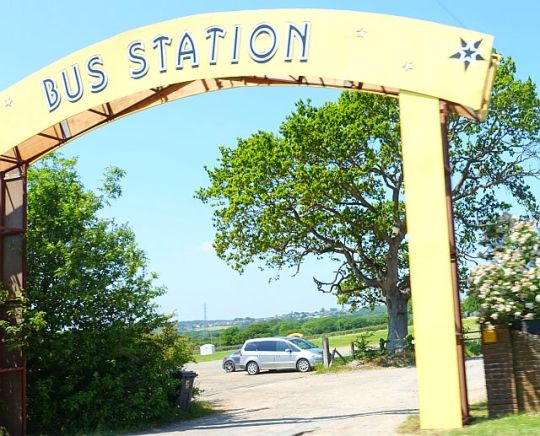
Wie wir sehen können, sind die Aufbauarbeiten bereits im Full Swing. Die Tore sind alle installiert und auf dem Gelände, das zwischen dem breiten River Medina und der A 3054 eingeklemmt ist, stehen schon etliche Zelte und auch Bühnenaufbauen.

Das Isle of Wight Festival findet bereits seit Ende der 60er Jahre, jeweils Mitte Mai, statt. Allerdings nicht durchgängig. Von Anfang an war das Line-up aber immer hochkarätig besetzt.
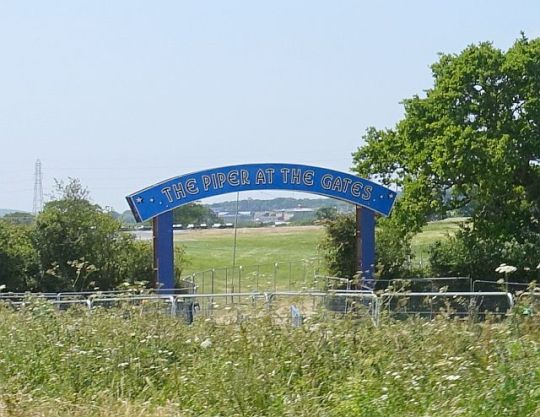
Wir müssen heute Abend leider noch packen, denn unsere Zeit auf der wunderschönen Isle of Wight ist zu Ende. Morgen geht es wieder auf die Fähre.
Good Night
Angie, Micha und Mister Bunnybear (Hasenbär)
3 notes
·
View notes
Photo

Neptune Resigning to Britannia the Empire of the Sea by William Dyce
See also The Twelve Senses, Forces & World Views
1 note
·
View note
Photo

William Dyce - Neptune Resigning to Britannia the Empire of the Sea, 1847.
2 notes
·
View notes
Text
“Over the years, despite Victoria's reputation for being prudish, the couple collected several extraordinarily erotic paintings, including a number of nudes by William Edward Frost, many of which were hung in the public rooms of their various homes. Victoria also ordered a statue of Lady Godiva by French sculptor Pierre-Emile Jeannest, whose work Albert admired, and gave it to her husband as a birthday gift in 1857. When the Queen commissioned Scottish artist William Dyce to paint a fresco entitled Neptune Resigning to Britannia the Empire of the Sea - a scene of writhing male and female nudes - Dyce said that Prince Albert was shocked. More privately, though, in Albert's bathroom at Osborne House there is an astonishing mural of Hercules in bondage to Queen Omphale.”
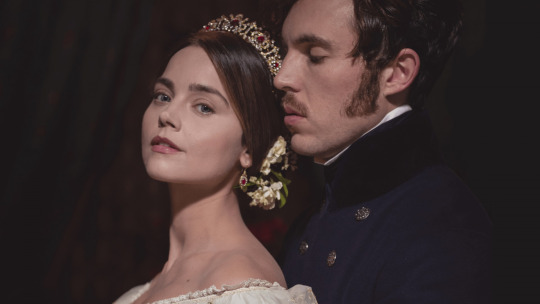
From “Victoria and Albert: A Royal Affair” by Sara Sheridan and Daisy Goodwin.
#victoria itv#victorian era#queen victoria#prince albert#period drama#historical drama#royal family#19th century#victorian
42 notes
·
View notes
Text



Depictions of Britannia (usually a version of Athena wielding a trident to represent Britain’s historical naval supremacy and accompanied by a lion)
Third image is a painting called *Neptune Resigning to Britannia the Empire of the Sea*
2 notes
·
View notes
Photo
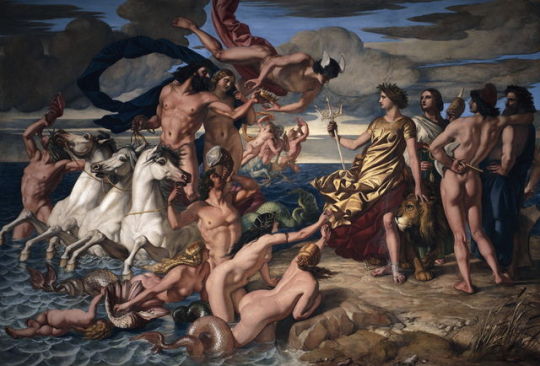
William Dyce (1806–1864), Neptune Resigning to Britannia the Empire of the Sea (1847),
215 notes
·
View notes
Photo
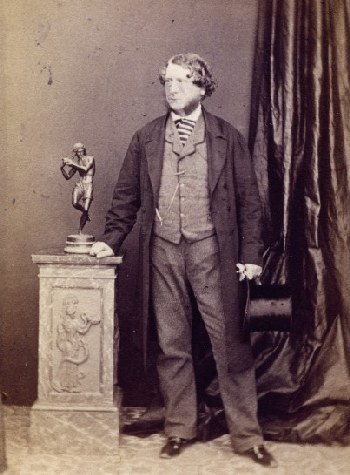
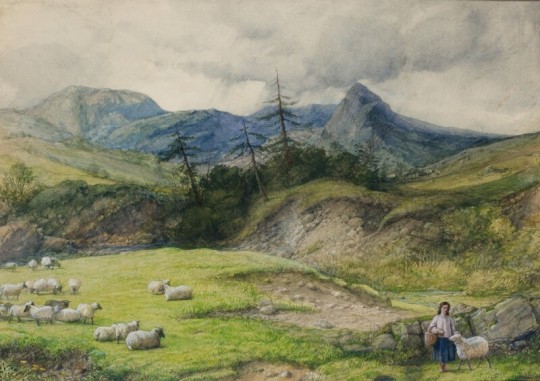
The Scottish painter William Dyce died on February 14th 1864 in Streatham.
Born at 48 Marischal Street in Aberdeen to a well off family William was educated at the Royal Academy schools, and then travelled to Rome for the first time in 1825. While he was there, he studied the works of Titian and Poussin.
Dyce was highly cultured and widely talented (he was an accomplished musician and wrote learned essays on antiquities and a prize-winning paper on electromagnetism), but initially he was successful mainly as a rather conventional portraitist in Edinburgh.
In 1837 he moved to London to work for the newly founded Government School of Design (which developed into the Royal College of Art) and he made a tour of state art schools in France and Germany to study their methods. His report on his findings led to his appointment as superintendent (director) of the School in 1840. He resigned in 1843, but he remained a central figure in the art world—indeed ‘there was no major [artistic] undertaking in mid nineteenth-century Britain in which he did not play either an executive or advisory role’.
In particular he was a key figure in the revival of fresco painting, which was stimulated mainly by the mural decoration (begun 1843) of the new Houses of Parliament. Dyce’s own work there has deteriorated badly, but his Neptune Resigning to Britannia the Empire of the Sea is one of the best preserved of all Victorian frescos. This was one of several royal commissions for Dyce, who was a favourite of Prince Albert. In addition to murals, he produced a varied range of easel paintings, from high-minded religious scenes (he was a devout Christian) to the delightfully sentimental Titian’s First Essay in Colour his Pegwell Bay, Kent is considered one of the most remarkable of all Victorian landscapes.
Dyce’s strong colours, firm outlines, naturalistic detail, and thoughtful sincerity of approach formed a bridge between the Nazarenes and the Pre-Raphaelites, and Ruskin said that it was Dyce who gave him his ‘real introduction’ to the Pre-Raphaelites when, at the 1850 Royal Academy exhibition, he ‘dragged me literally up to the Millais picture of the Carpenter’s Shop, which I had passed disdainfully, and forced me to look for its merits’.
He was working on the frescoes in Westminster when he collapsed, and later died at his home in Streatham on 14 February 1864. He was buried at St Leonard’s Church, Streatham. A nearby drinking fountain, designed in the neo-Gothic style by Dyce, was subsequently dedicated to him by the parishioners.
Pics are Dyce, Glen Rosa, Isle of Arran and Loch Lomond.
23 notes
·
View notes
Photo
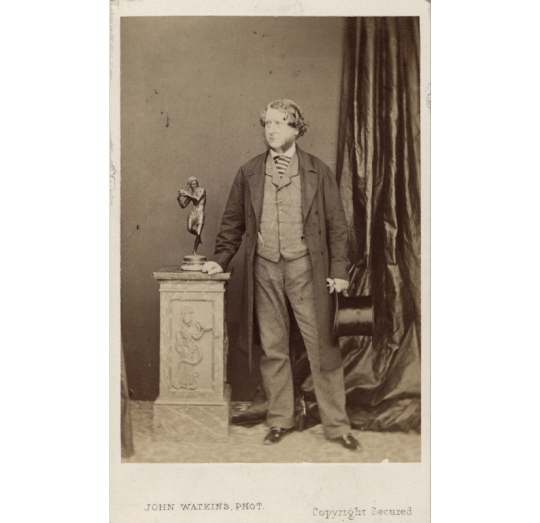
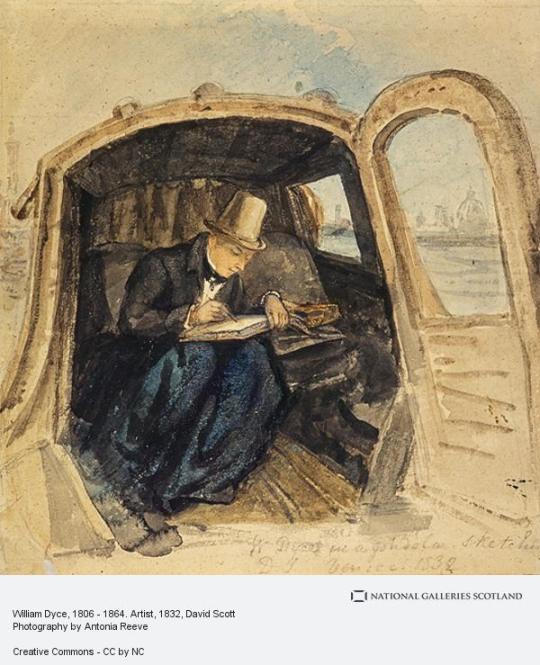


19th September 1806 saw the birth of William Dyce, the painter and educator.
Born at 48 Marischal Street in Aberdeen to a well off family William was educated at the Royal Academy schools, and then travelled to Rome for the first time in 1825. While he was there, he studied the works of Titian and Poussin.
Dyce was highly cultured and widely talented (he was an accomplished musician and wrote learned essays on antiquities and a prize-winning paper on electromagnetism), but initially he was successful mainly as a rather conventional portraitist in Edinburgh.
In 1837 he moved to London to work for the newly founded Government School of Design (which developed into the Royal College of Art) and he made a tour of state art schools in France and Germany to study their methods. His report on his findings led to his appointment as superintendent (director) of the School in 1840. He resigned in 1843, but he remained a central figure in the art world—indeed ‘there was no major [artistic] undertaking in mid nineteenth-century Britain in which he did not play either an executive or advisory role’.
In particular he was a key figure in the revival of fresco painting, which was stimulated mainly by the mural decoration (begun 1843) of the new Houses of Parliament. Dyce’s own work there has deteriorated badly, but his Neptune Resigning to Britannia the Empire of the Sea is one of the best preserved of all Victorian frescos. This was one of several royal commissions for Dyce, who was a favourite of Prince Albert. In addition to murals, he produced a varied range of easel paintings, from high-minded religious scenes (he was a devout Christian) to the delightfully sentimental Titian’s First Essay in Colour his Pegwell Bay, Kent is considered one of the most remarkable of all Victorian landscapes.
Dyce’s strong colours, firm outlines, naturalistic detail, and thoughtful sincerity of approach formed a bridge between the Nazarenes and the Pre-Raphaelites, and Ruskin said that it was Dyce who gave him his ‘real introduction’ to the Pre-Raphaelites when, at the 1850 Royal Academy exhibition, he ‘dragged me literally up to the Millais picture of the Carpenter’s Shop, which I had passed disdainfully, and forced me to look for its merits’.
He was working on the frescoes in Westminster when he collapsed, and later died at his home in Streatham on 14 February 1864. He was buried at St Leonard’s Church, Streatham. A nearby drinking fountain, designed in the neo-Gothic style by Dyce, was subsequently dedicated to him by the parishioners.
14 notes
·
View notes
Photo
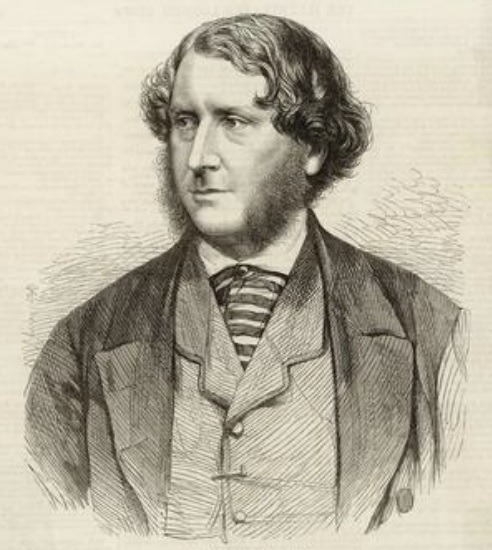
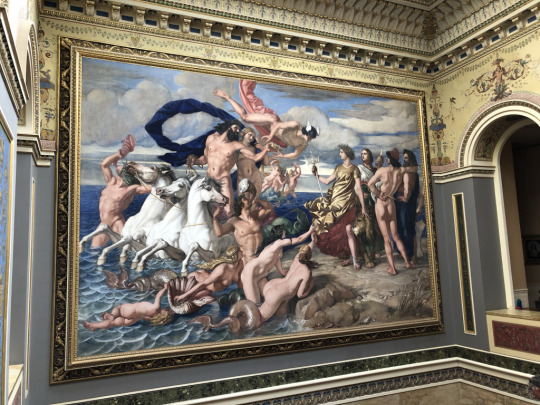
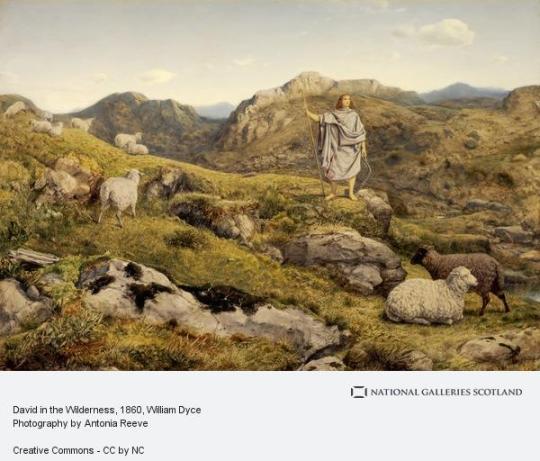


The Scottish painter William Dyce died on February 14th 1864 in Streatham.
Born in Aberdeen to a well off family William was educated at the Royal Academy schools, and then travelled to Rome for the first time in 1825. While he was there, he studied the works of Titian and Poussin.
Dyce was highly cultured and widely talented (he was an accomplished musician and wrote essays on antiquities and a prize-winning paper on electromagnetism), but initially he was successful mainly as a rather conventional portraitist in Edinburgh.
In 1837 he moved to London to work for the newly founded Government School of Design (which developed into the Royal College of Art) and he made a tour of state art schools in France and Germany to study their methods. His report on his findings led to his appointment as superintendent (director) of the School in 1840. He resigned in 1843, but he remained a central figure in the art world—indeed ‘there was no major [artistic] undertaking in mid nineteenth-century Britain in which he did not play either an executive or advisory role’.
His Neptune Resigning to Britannia the Empire of the Sea is one of the best preserved of all Victorian frescos and is considered a masterpiece, as seen in the second pic. This was one of several royal commissions for Dyce, who was a favourite of Prince Albert. In addition to murals, he produced a varied range of easel paintings, from high-minded religious scenes (he was a devout Christian)
He was working on frescoes in Westminster when he collapsed, and later died at his home in Streatham on 14th February 1864. He was buried at St Leonard's Church, Streatham. A nearby drinking fountain, designed in the neo-Gothic style by Dyce, was dedicated to him by the parishioners.
The pics are of the artist, the aforementioned Neptune Resigning, The Head of Christ, David in the Wilderness and A Scene in Arran.
You can find more of his work here http://www.hellenicaworld.com/Art/Paintings/en/WilliamDyce.html
15 notes
·
View notes
Photo
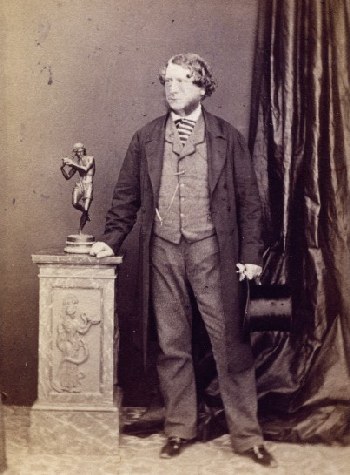

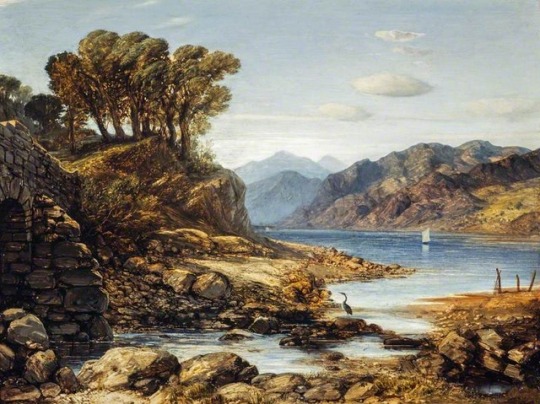
19th September 1806 saw the birth of William Dyce, the painter and educator.
Born at 48 Marischal Street in Aberdeen to a well off family William was educated at the Royal Academy schools, and then travelled to Rome for the first time in 1825. While he was there, he studied the works of Titian and Poussin.
Dyce was highly cultured and widely talented (he was an accomplished musician and wrote learned essays on antiquities and a prize-winning paper on electromagnetism), but initially he was successful mainly as a rather conventional portraitist in Edinburgh.
In 1837 he moved to London to work for the newly founded Government School of Design (which developed into the Royal College of Art) and he made a tour of state art schools in France and Germany to study their methods. His report on his findings led to his appointment as superintendent (director) of the School in 1840. He resigned in 1843, but he remained a central figure in the art world—indeed ‘there was no major [artistic] undertaking in mid nineteenth-century Britain in which he did not play either an executive or advisory role’.
In particular he was a key figure in the revival of fresco painting, which was stimulated mainly by the mural decoration (begun 1843) of the new Houses of Parliament. Dyce's own work there has deteriorated badly, but his Neptune Resigning to Britannia the Empire of the Sea is one of the best preserved of all Victorian frescos. This was one of several royal commissions for Dyce, who was a favourite of Prince Albert. In addition to murals, he produced a varied range of easel paintings, from high-minded religious scenes (he was a devout Christian) to the delightfully sentimental Titian's First Essay in Colour his Pegwell Bay, Kent is considered one of the most remarkable of all Victorian landscapes.
Dyce's strong colours, firm outlines, naturalistic detail, and thoughtful sincerity of approach formed a bridge between the Nazarenes and the Pre-Raphaelites, and Ruskin said that it was Dyce who gave him his ‘real introduction’ to the Pre-Raphaelites when, at the 1850 Royal Academy exhibition, he ‘dragged me literally up to the Millais picture of the Carpenter's Shop, which I had passed disdainfully, and forced me to look for its merits’.
He was working on the frescoes in Westminster when he collapsed, and later died at his home in Streatham on 14 February 1864. He was buried at St Leonard's Church, Streatham. A nearby drinking fountain, designed in the neo-Gothic style by Dyce, was subsequently dedicated to him by the parishioners.
The pics are of Dyce, King Lear and the Fool in the Storm and View of Loch Lomond by the artist.
5 notes
·
View notes